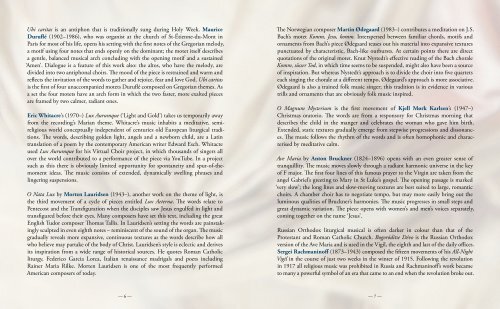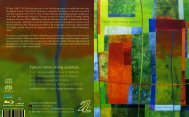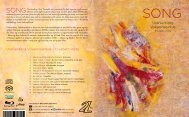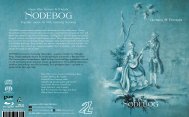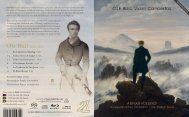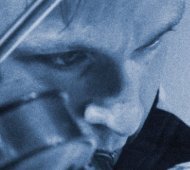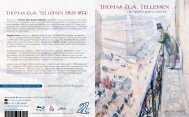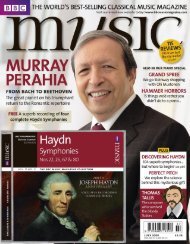Create successful ePaper yourself
Turn your PDF publications into a flip-book with our unique Google optimized e-Paper software.
Ubi caritas is an antiphon that is traditionally sung during Holy Week. Maurice<br />
Duruflé (1902–1986), who was organist at <strong>the</strong> church of St-Étienne-du-Mont in<br />
Paris for most of his life, opens his setting with <strong>the</strong> first notes of <strong>the</strong> Gregorian melody,<br />
a motif using four notes that ends openly on <strong>the</strong> dominant; <strong>the</strong> motet itself describes<br />
a gentle, balanced musical arch concluding with <strong>the</strong> opening motif and a sustained<br />
‘Amen’. Dialogue is a feature of this work also: <strong>the</strong> al<strong>to</strong>s, who have <strong>the</strong> melody, are<br />
divided in<strong>to</strong> two antiphonal choirs. The mood of <strong>the</strong> piece is restrained and warm and<br />
reflects <strong>the</strong> invitation of <strong>the</strong> words <strong>to</strong> ga<strong>the</strong>r and rejoice, fear and love God. Ubi caritas<br />
is <strong>the</strong> first of four unaccompanied motets Duruflé composed on Gregorian <strong>the</strong>mes. As<br />
a set <strong>the</strong> four motets have an arch form in which <strong>the</strong> two faster, more exalted pieces<br />
are framed by two calmer, radiant ones.<br />
Eric Whitacre’s (1970–) Lux Aurumque (‘Light and Gold’) takes us temporarily away<br />
from <strong>the</strong> recording’s Marian <strong>the</strong>me. Whitacre’s music inhabits a meditative, semi-<br />
religious world conceptually independent of centuries old European liturgical traditions.<br />
The words, describing golden light, angels and a newborn child, are a Latin<br />
translation of a poem by <strong>the</strong> contemporary American writer Edward Esch. Whitacre<br />
used Lux Aurumque for his Virtual Choir project, in which thousands of singers all<br />
over <strong>the</strong> world contributed <strong>to</strong> a performance of <strong>the</strong> piece via YouTube. In a project<br />
such as this <strong>the</strong>re is obviously limited opportunity for spontaneity and spur-of-<strong>the</strong>moment<br />
ideas. The music consists of extended, dynamically swelling phrases and<br />
lingering suspensions.<br />
O Nata Lux by Morten Lauridsen (1943–), ano<strong>the</strong>r work on <strong>the</strong> <strong>the</strong>me of light, is<br />
<strong>the</strong> third movement of a cycle of pieces entitled Lux Aeterna. The words relate <strong>to</strong><br />
Pentecost and <strong>the</strong> Transfiguration when <strong>the</strong> disciples saw Jesus engulfed in light and<br />
transfigured before <strong>the</strong>ir eyes. Many composers have set this text, including <strong>the</strong> great<br />
English Tudor composer Thomas Tallis. In Lauridsen’s setting <strong>the</strong> words are painstakingly<br />
sculpted in even eighth notes – reminiscent of <strong>the</strong> sound of <strong>the</strong> organ. The music<br />
gradually reveals more expansive, continuous textures as <strong>the</strong> words describe how all<br />
who believe may partake of <strong>the</strong> body of Christ. Lauridsen’s style is eclectic and derives<br />
its inspiration from a wide range of his<strong>to</strong>rical sources. He quotes Roman Catholic<br />
liturgy, Federico Garcia Lorca, Italian renaissance madrigals and poets including<br />
Rainer Maria Rilke. Morten Lauridsen is one of <strong>the</strong> most frequently performed<br />
American composers of <strong>to</strong>day.<br />
— 6 —<br />
The Norwegian composer Martin Ødegaard (1983–) contributes a meditation on J.S.<br />
Bach’s motet Komm, Jesu, komm. Interspersed between familiar chords, motifs and<br />
ornaments from Bach’s piece Ødegaard teases out his material in<strong>to</strong> expansive textures<br />
punctuated by characteristic, Bach-like outbursts. At certain points <strong>the</strong>re are direct<br />
quotations of <strong>the</strong> original motet. Knut Nystedt’s effective reading of <strong>the</strong> Bach chorale<br />
Komm, süsser Tod, in which time seems <strong>to</strong> be suspended, might also have been a source<br />
of inspiration. But whereas Nystedt’s approach is <strong>to</strong> divide <strong>the</strong> choir in<strong>to</strong> five quartets<br />
each singing <strong>the</strong> chorale at a different tempo, Ødegaard’s approach is more associative.<br />
Ødegaard is also a trained folk music singer; this tradition is in evidence in various<br />
trills and ornaments that are obviously folk music inspired.<br />
O Magnum Mysterium is <strong>the</strong> first movement of Kjell Mørk Karlsen’s (1947–)<br />
Christmas ora<strong>to</strong>rio. The words are from a responsory for Christmas morning that<br />
describes <strong>the</strong> child in <strong>the</strong> manger and celebrates <strong>the</strong> woman who gave him birth.<br />
Extended, static textures gradually emerge from stepwise progressions and dissonances.<br />
The music follows <strong>the</strong> rhythm of <strong>the</strong> words and is often homophonic and characterised<br />
by meditative calm.<br />
Ave Maria by An<strong>to</strong>n Bruckner (1824–1896) opens with an even greater sense of<br />
tranquillity. The music moves slowly through a radiant harmonic universe in <strong>the</strong> key<br />
of F major. The first four lines of this famous prayer <strong>to</strong> <strong>the</strong> <strong>Virgin</strong> are taken from <strong>the</strong><br />
angel Gabriel’s greeting <strong>to</strong> Mary in St Luke’s gospel. The opening passage is marked<br />
‘very slow’; <strong>the</strong> long lines and slow-moving textures are best suited <strong>to</strong> large, romantic<br />
choirs. A chamber choir has <strong>to</strong> negotiate tempo, but may more easily bring out <strong>the</strong><br />
luminous qualities of Bruckner’s harmonies. The music progresses in small steps and<br />
great dynamic variation. The piece opens with women’s and men’s voices separately,<br />
coming <strong>to</strong>ge<strong>the</strong>r on <strong>the</strong> name ‘Jesus’.<br />
Russian Orthodox liturgical musical is often darker in colour than that of <strong>the</strong><br />
Protestant and Roman Catholic Church. Bogoróditse Dévo is <strong>the</strong> Russian Orthodox<br />
version of <strong>the</strong> Ave Maria and is used in <strong>the</strong> Vigil, <strong>the</strong> eighth and last of <strong>the</strong> daily offices.<br />
Sergei Rachmaninoff (1873–1943) composed <strong>the</strong> fifteen movements of his All-Night<br />
Vigil in <strong>the</strong> course of just two weeks in <strong>the</strong> winter of 1915. Following <strong>the</strong> revolution<br />
in 1917 all religious music was prohibited in Russia and Rachmaninoff’s work became<br />
<strong>to</strong> many a powerful symbol of an era that came <strong>to</strong> an end when <strong>the</strong> revolution broke out.<br />
— 7 —


